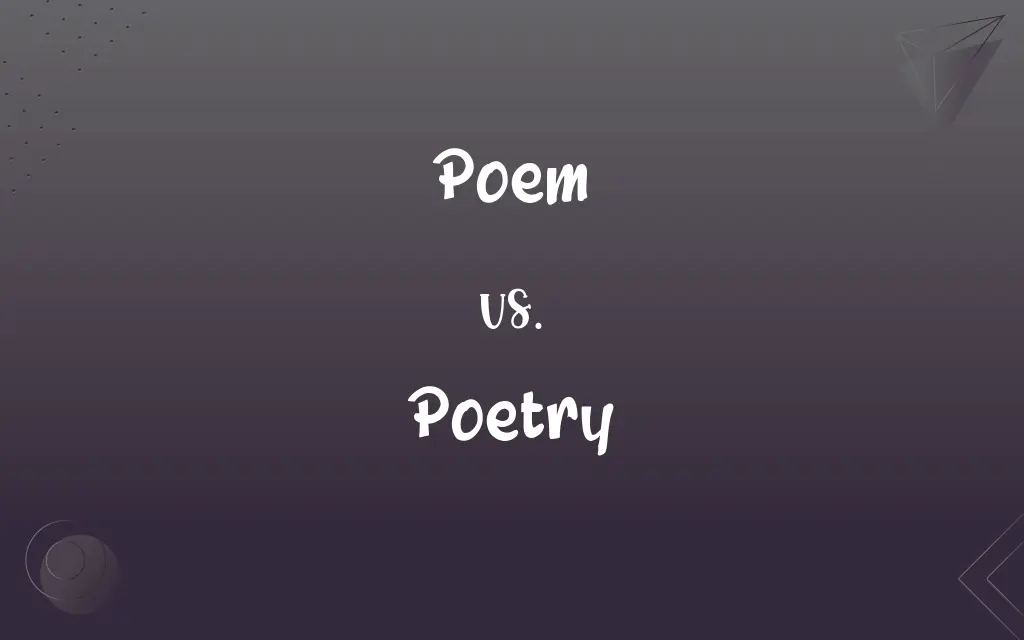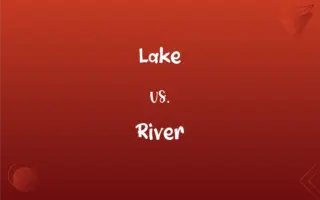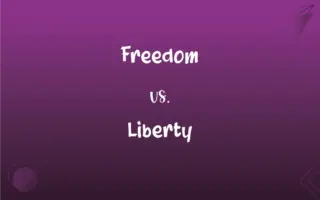Poem vs. Poetry: What's the Difference?
Edited by Janet White || By Harlon Moss || Updated on October 9, 2023
A poem is an individual work, while poetry is the art form or collective of poems.

Key Differences
A poem is generally considered a piece of writing that utilizes a structured form to convey emotions, images, or stories, presenting ideas in a rhythmic and/or rhymed format to elicit emotional responses. Poetry, on the other hand, is more of a broad artistic medium that encompasses all forms and styles of such written expressions, acting as an umbrella term that houses various forms of poetic expression. While a poem adheres to specific structures, rhythms, or styles to convey messages, poetry as an art form captures a wide array of structured and unstructured, rhymed and unrhymed expressions. Thus, while a poem is a product created, poetry is the overarching method and genre of expression which allows those products to exist and be categorized.
In another light, poetry exemplifies a creative approach towards language, emphasizing aesthetic and rhythmic qualities to evoke meanings in addition to, or in place of, the standard apparent meaning. Poems then become the physical entities, the written pieces that bring this art form, poetry, to life, transforming abstract, emotive communication into tangible, readable works. It’s essential to note that while all poems belong to the category of poetry, not all aspects of poetry are confined to the structured limitations of a poem. Poetry can exist in various forms and styles, while a poem is a defined piece of work structured to exhibit poetic qualities.
Poetry is universally recognized as a form of art, a method of communication, and a means of expression, often employed to explore a variety of subjects, emotions, and themes. Every poem, therefore, can be considered a unique manifestation of poetry, crafted with an individual set of patterns, rhymes, and meanings, focusing on a particular theme or emotion. While poetry could be considered a language in itself, a language that interprets and conveys deeper emotional truths, a poem is a conversation in that language, employing specific words, forms, and structures to convey a focused thought or emotion.
Conversely, a poem may follow specific patterns, rules, or styles such as sonnets, haikus, or limericks, each with its defined parameters regarding rhyme, meter, and thematic elements. Poetry, on the other hand, remains as the larger conceptual domain which does not conform to specific structures and spans beyond the customary bounds of rhythmic and thematic constraints. A poem might be thought of as a piece of architecture, constructed with meticulous attention to detail and design, whereas poetry might be envisioned as the art of architectural design itself, limitless, boundless, and perpetually evolving.
Although poetry serves as a platform that may embrace, intertwine, or reject various linguistic and structural forms, each poem essentially is a solidified manifestation of the seemingly boundless entity that is poetry, captured, and preserved in a defined form and space. While a poem may symbolize a droplet of emotion or a snippet of universal truth, extracted and encapsulated within the boundaries of its structure, poetry resembles the vast ocean from which these individual droplets are derived, containing within it an infinite spectrum of emotions, experiences, and expressions, waiting to be discovered, explored, and ultimately transformed into poems. Thus, poems become the vehicles through which the essence of poetry is conveyed, each one navigating different paths, exploring varied themes, and expressing diverse emotions through its journey within the expansive universe of poetic artistry.
ADVERTISEMENT
Comparison Chart
Definition
A composed piece of writing
The art of writing poems
Grammatical Use
Noun (refers to one work)
Noun (refers to the medium)
Countability
Countable (one poem, two poems)
Uncountable (a body of work)
Relation to Writer
Product of a poet
Craft or skill of a poet
Temporality
Specific moment or feeling
Timeless, expansive art
ADVERTISEMENT
Poem and Poetry Definitions
Poem
A poem is a standalone piece within the wider realm of poetry.
This poem is a wonderful addition to modern poetry.
Poetry
Poetry is the art of creating evocative compositions through words.
Poetry has the power to move hearts and change perspectives.
Poem
A poem often follows rhythmic patterns and may rhyme.
His poem, with its steady beat, captivated the audience.
Poetry
Poetry is the collective of poems, representing human expression across ages.
The anthology covered centuries of English poetry.
Poem
A poem can capture emotions, stories, or scenes in concise form.
The poem painted a vivid picture of a winter morning.
Poetry
Poetry encompasses various styles, themes, and forms.
His love for poetry began with reading classic sonnets.
Poem
A poem provides insight into the poet's mind or the world.
Her poem revealed her deep love for nature.
Poetry
Poetry is a medium that transcends cultural and linguistic boundaries.
Poetry from different countries offers a window into diverse souls.
Poem
A poem is a crafted composition using language artistically.
She read her favorite poem aloud to the class.
Poetry
Poetry is the essence that makes verses and lines resonate.
The simplicity of his words was pure poetry.
Poem
A verbal composition designed to convey experiences, ideas, or emotions in a vivid and imaginative way, characterized by the use of language chosen for its sound and suggestive power and by the use of literary techniques such as meter, metaphor, and rhyme.
Poetry
The act or practice of composing poems.
Poetry
Poems regarded as forming a division of literature.
FAQs
What is poetry?
Poetry is the art form or collective of poems.
Is all poetry poetic?
While all poetry aims to be poetic, the resonance of its poetic nature is subjective and varies among readers.
What is a poem?
A poem is a standalone composition crafted to evoke emotions or convey a message.
How many lines make a poem?
A poem can be of any length, from a single line (monostich) to hundreds of lines.
How do you interpret a poem?
By analyzing its language, form, themes, and cultural or personal context, often aided by literary tools.
Can one poem belong to multiple genres of poetry?
Yes, a poem can incorporate elements from various genres or styles.
Why are some poems difficult to understand?
Poems can have layered meanings, cultural references, or employ complex poetic devices, requiring deep analysis.
Can poetry be translated effectively?
While translations can convey basic meaning, the nuances, rhythm, and cultural essence might be challenging to capture fully.
What differentiates a poem from prose?
A poem often has structured rhythms, may rhyme, and places emphasis on aesthetic and evocative qualities.
How has poetry evolved over time?
Poetry has seen various movements, styles, and themes, influenced by cultural, historical, and personal contexts.
What makes a piece of writing "poetic"?
Its ability to evoke deep emotion, its use of figurative language, and its artistic presentation.
Can a text be considered a poem if it doesn't rhyme?
Yes, not all poems need to rhyme; it's the essence and expression that matters.
What is the purpose of a poem?
A poem can entertain, inform, evoke emotions, or offer insight into human experiences and the world.
Can anything be turned into a poem?
With creativity and insight, most subjects can be explored through a poem.
Is there a set structure for poetry?
While there are structured forms like sonnets, poetry as a medium is vast and allows for free form and experimentation.
How is modern poetry different from classic poetry?
Modern poetry might diverge from traditional forms, themes, or rules, reflecting contemporary experiences and thoughts.
How does one study poetry?
By reading a diverse range of poems, understanding poetic devices, and often through guided literary analysis.
Are song lyrics considered poems?
Song lyrics can have poetic qualities and some are considered poems, but not all lyrics are poems in a literary sense.
Why is poetry important?
Poetry provides a unique medium for expression, fosters empathy, and connects individuals across time and culture.
What's the difference between a poet and a writer?
While all poets are writers, not all writers are poets. Poets specifically craft poems, focusing on the artistry of words in a condensed form.
About Author
Written by
Harlon MossHarlon is a seasoned quality moderator and accomplished content writer for Difference Wiki. An alumnus of the prestigious University of California, he earned his degree in Computer Science. Leveraging his academic background, Harlon brings a meticulous and informed perspective to his work, ensuring content accuracy and excellence.
Edited by
Janet WhiteJanet White has been an esteemed writer and blogger for Difference Wiki. Holding a Master's degree in Science and Medical Journalism from the prestigious Boston University, she has consistently demonstrated her expertise and passion for her field. When she's not immersed in her work, Janet relishes her time exercising, delving into a good book, and cherishing moments with friends and family.































































